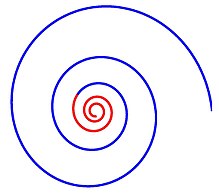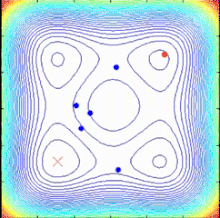
In mathematics, the spiral optimization (SPO) algorithm is a metaheuristic inspired by spiral phenomena in nature.
The first SPO algorithm was proposed for two-dimensional unconstrained optimization based on two-dimensional spiral models. This was extended to n-dimensional problems by generalizing the two-dimensional spiral model to an n-dimensional spiral model. There are effective settings for the SPO algorithm: the periodic descent direction setting and the convergence setting.
Metaphor
The motivation for focusing on spiral phenomena was due to the insight that the dynamics that generate logarithmic spirals share the diversification and intensification behavior. The diversification behavior can work for a global search (exploration) and the intensification behavior enables an intensive search around a current found good solution (exploitation).
Algorithm

The SPO algorithm is a multipoint search algorithm that has no objective function gradient, which uses multiple spiral models that can be described as deterministic dynamical systems. As search points follow logarithmic spiral trajectories towards the common center, defined as the current best point, better solutions can be found and the common center can be updated.
The general SPO algorithm for a minimization problem under the maximum iteration (termination criterion) is as follows:
0) Set the number of search points and the maximum iteration number . 1) Place the initial search points and determine the center , ,and then set . 2) Decide the step rate by a rule. 3) Update the search points: 4) Update the center: where . 5) Set . If is satisfied then terminate and output . Otherwise, return to Step 2).
Setting
The search performance depends on setting the composite rotation matrix , the step rate , and the initial points . The following settings are new and effective.
Setting 1 (Periodic Descent Direction Setting)
This setting is an effective setting for high dimensional problems under the maximum iteration . The conditions on and together ensure that the spiral models generate descent directions periodically. The condition of works to utilize the periodic descent directions under the search termination .
- Set as follows: where is the identity matrix and is the zero vector.
- Place the initial points at random to satisfy the following condition:
where . Note that this condition is almost all satisfied by a random placing and thus no check is actually fine.
- Set at Step 2) as follows: where a sufficiently small such as or .
Setting 2 (Convergence Setting)
This setting ensures that the SPO algorithm converges to a stationary point under the maximum iteration . The settings of and the initial points are the same with the above Setting 1. The setting of is as follows.
- Set at Step 2) as follows: where is an iteration when the center is newly updated at Step 4) and such as . Thus we have to add the following rules about to the Algorithm:
- •(Step 1) .
- •(Step 4) If then .
Future works
- The algorithms with the above settings are deterministic. Thus, incorporating some random operations make this algorithm powerful for global optimization. Cruz-Duarte et al. demonstrated it by including stochastic disturbances in spiral searching trajectories. However, this door remains open to further studies.
- To find an appropriate balance between diversification and intensification spirals depending on the target problem class (including ) is important to enhance the performance.
Extended works
Many extended studies have been conducted on the SPO due to its simple structure and concept; these studies have helped improve its global search performance and proposed novel applications.
References
- Tamura, K.; Yasuda, K. (2011). "Primary Study of Spiral Dynamics Inspired Optimization". IEEJ Transactions on Electrical and Electronic Engineering. 6 (S1): 98–100. doi:10.1002/tee.20628. S2CID 109093423.
- Tamura, K.; Yasuda, K. (2011). "Spiral Dynamics Inspired Optimization". Journal of Advanced Computational Intelligence and Intelligent Informatics. 132 (5): 1116–1121. doi:10.20965/jaciii.2011.p1116.
- ^ Tamura, K.; Yasuda, K. (2016). "Spiral Optimization Algorithm Using Periodic Descent Directions". SICE Journal of Control, Measurement, and System Integration. 6 (3): 133–143. Bibcode:2016JCMSI...9..134T. doi:10.9746/jcmsi.9.134.
- ^ Tamura, K.; Yasuda, K. (2020). "The Spiral Optimization Algorithm: Convergence Conditions and Settings". IEEE Transactions on Systems, Man, and Cybernetics: Systems. 50 (1): 360–375. doi:10.1109/TSMC.2017.2695577. S2CID 126109444.
- Cruz-Duarte, Jorge M.; Martin-Diaz, Ignacio; Munoz-Minjares, J. U.; Sanchez-Galindo, Luis A.; Avina-Cervantes, Juan G.; Garcia-Perez, Arturo; Correa-Cely, C. Rodrigo (2017). "Primary study on the stochastic spiral optimization algorithm". 2017 IEEE International Autumn Meeting on Power, Electronics and Computing (ROPEC). pp. 1–6. doi:10.1109/ROPEC.2017.8261609. ISBN 978-1-5386-0819-7. S2CID 37580653.
- Nasir, A. N. K.; Tokhi, M. O. (2015). "An improved spiral dynamic optimization algorithm with engineering application". IEEE Transactions on Systems, Man, and Cybernetics: Systems. 45 (6): 943–954. doi:10.1109/tsmc.2014.2383995. S2CID 24253496.
- Nasir, A. N. K.; Ismail, R.M.T.R.; Tokhi, M. O. (2016). "Adaptive spiral dynamics metaheuristic algorithm for global optimisation with application to modelling of a flexible system" (PDF). Applied Mathematical Modelling. 40 (9–10): 5442–5461. doi:10.1016/j.apm.2016.01.002.
- Ouadi, A.; Bentarzi, H.; Recioui, A. (2013). "multiobjective design of digital filters using spiral optimization technique". SpringerPlus. 2 (461): 697–707. doi:10.1186/2193-1801-2-461. PMC 3786071. PMID 24083108.
- Benasla, L.; Belmadani, A.; Rahli, M. (2014). "Spiral optimization algorithm for solving combined economic and Emission Dispatch". International Journal of Electrical Power & Energy Systems. 62: 163–174. Bibcode:2014IJEPE..62..163B. doi:10.1016/j.ijepes.2014.04.037.
- Sidarto, K. A.; Kania, A. (2015). "Finding all solutions of systems of nonlinear equations using spiral dynamics inspired optimization with clustering". Journal of Advanced Computational Intelligence and Intelligent Informatics. 19 (5): 697–707. doi:10.20965/jaciii.2015.p0697.
- Kaveh, A.; Mahjoubi, S. (October 2019). "Hypotrochoid spiral optimization approach for sizing and layout optimization of truss structures with multiple frequency constraints". Engineering with Computers. 35 (4): 1443–1462. doi:10.1007/s00366-018-0675-6. S2CID 54457145.
| Optimization: Algorithms, methods, and heuristics | ||||||||||||||||||
|---|---|---|---|---|---|---|---|---|---|---|---|---|---|---|---|---|---|---|
|  | |||||||||||||||||
| ||||||||||||||||||
| ||||||||||||||||||
| ||||||||||||||||||
| ||||||||||||||||||
 (termination criterion) is as follows:
(termination criterion) is as follows:
 and the maximum iteration number
and the maximum iteration number  and determine the center
and determine the center  ,
,  ,and then set
,and then set  .
2) Decide the step rate
.
2) Decide the step rate  by a rule.
3) Update the search points:
by a rule.
3) Update the search points:  4) Update the center:
4) Update the center:  where
where  .
5) Set
.
5) Set  . If
. If  is satisfied then terminate and output
is satisfied then terminate and output  . Otherwise, return to Step 2).
. Otherwise, return to Step 2).
 , the step rate
, the step rate  .
The following settings are new and effective.
.
The following settings are new and effective.
 where
where  is the
is the  identity matrix and
identity matrix and  is the
is the  zero vector.
zero vector.
 at random to satisfy the following condition:
at random to satisfy the following condition: where
where  . Note that this condition is almost all satisfied by a random placing and thus no check is actually fine.
. Note that this condition is almost all satisfied by a random placing and thus no check is actually fine.
 where a sufficiently small
where a sufficiently small  such as
such as  or
or  .
. . The settings of
. The settings of  where
where  is an
is an  such as
such as  . Thus we have to add the following rules about
. Thus we have to add the following rules about  .
. then
then  .
.